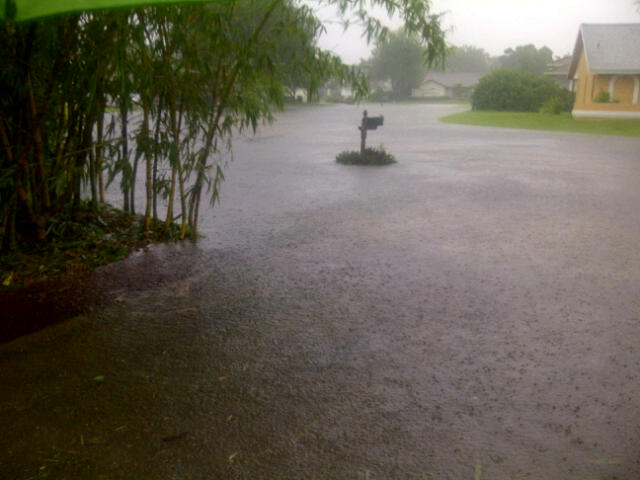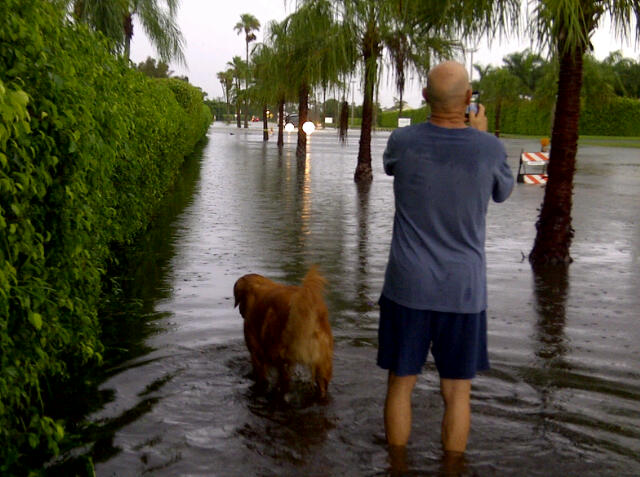our street during isaac, 2012
+++
My family moved from Caracas, Venezuela to South Florida in November 1963, the same year that Kennedy was assassinated. I was in boarding school in Massachusetts when that move took place, and spent my first Christmas in the U.S. that December. I hated it, hated that I didn’t have a chance to say a proper good-bye to Venezuela, the place where I had lived for nearly 17 years.
In the years since, my relationship with this state has morphed from disdain to love. Florida is home. It has been the setting for most of my novels. I love this state’s diversity. I love the fact that I can drive through some cities and neighborhoods and never hear a word of English. I love its access to the Bahamas, the Caribbean, South America.
When my parents moved to Boca Raton in 1963, the town consisted of three stoplights. As of 2013, Boca’s population was nearly 90,000. In 1963, there were still mangroves in the Intracoastal canal – my parents lived across the canal from one of them. Mangroves still existed along the South Florida coast. These wild thickets that survive in briny water are natural buffers against hurricanes and the erosion of the beaches.
Today, most of the mangroves are found in the ever shrinking Everglades. With the Atlantic coast buried in high rises and asphalt, construction has moved farther and farther west, encroaching on the Everglades. Our town, Wellington, used to be part of that wilderness. Melaleuca trees were brought in to soak up the water, canals were built were built to manage the water levels, dirt was brought in to elevate the land. Welcome to suburbia.
When we first moved here 16 years ago, Rob and I would spot foxes on our bike rides. We would hear the disturbing roar of alligators mating every spring. Because we’re so close to the Everglades, we were treated to some of its wildlife. But not anymore.
In 2012, a band of violent weather from Hurricane Isaac stalled over our area for several days and the rain was so extreme our neighborhood flooded. The drainage systems couldn’t get rid of the excessive water fast enough. The water rose through our yard, almost to our front door. We were stuck in the house for two days.
In Miami Beach, it doesn’t even have to rain for this happen. It just has to be high tide.
When my family moved here, the hottest months were June to September or October; we could count on beautiful weather the rest of the time and that meant temperate nights and no air conditioning. In 2015, March, April, and May were the hottest ever recorded in South Florida since the late 1800s, when such records were started. 2016 has already set heat records here and may go on record as the hottest year ever.
If the Arctic continues to melt, as it’s doing at a much faster rate than scientists predicted, most of South Florida can expect to joint the ranks of Atlantis. The middle of the state may fare better. Orlando is 82 feet above sea level. Gainesville, where the University of Florida is located, is 151 feet above sea level. These areas may survive the encroachment of the oceans as islands.
Several years ago, I started a Mira Morales novel where her husband, Wayne Sheppard, was flying a small plane back to Tango Key from Homestead, and got caught in a violent storm. He subsequently ended up flying into a future where climate change was a reality. The story depressed me so deeply that I stopped writing it.
Climate change deniers are abundant among U.S. politicians. Trump is one of them. He just can’t imagine Mar del Lago sinking beneath the sea. Former senator Marco Rubio surveys the ruin in the streets of Miami Beach on a sunny day and says the drains have backed up, that’s all. Florida’s Governor Rick Scott is of the same ilk; he forbade agencies in the state to use the words climate change or global warming.
So, here we are in late September 2016, where our weather forecast reports temps in the 90s, with humidity nearly that high, and a little addition called feels like. And that figure typically falls in the triple digits, usually between 102-105 degrees Fahrenheit.
Time to move? Probably. But if you run from what you fear, does that thing follow you?










Nailed it, absolutely. Our city, the Nation’s oldest city, is actually BELOW sea level by almost two feet. When high tides occur during full moon cycles, historic downtown floods. We have a newly reconstructed sea wall on the bayfront, but it doesn’t stop the water from flooding the streets to the point where vehicles cannot navigate through them. Foolishly, there are often young folks being pulled on water boards by the huge
high-rise trucks through the streets. (These trucks are the ones with the gigantic tires that can go thru the water.) Fortunately, altho we live on the beach, out townhouse was built on a hill, so even in hurricanes we face wind damage, etc., but not water. The people who don’t take global warming seriously are, in my opinion, stupid and ignorant.
To deny climate change is insanity. The former vice president of the U.S., Al Gore, demonstrated that in his 2006 film “An Inconvenient Truth”, and virtually the entire scientific community concurs. The melting of the poles and rising sea levels in the South Pacific, causing entire island populations to be relocated – is a visual record easily visible simply by using Google or UTube. Numerous countries, like France for example, are making preparations for climate change. That climate change is not even discussed in this election is insane and unbelievably irresponsible. And that one of the candidates is actually, in the face of all that overwhelming evidence, denying this reality – is incredibly immoral. We are talking about the future of our children, in fact, all children of the future. What is happening in this country will impact countless generations to come.
You nailed it, Lauren.